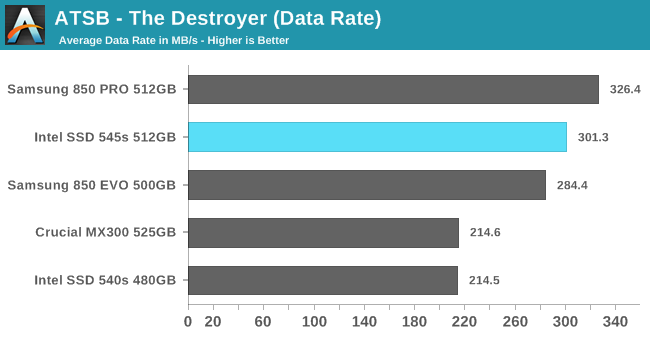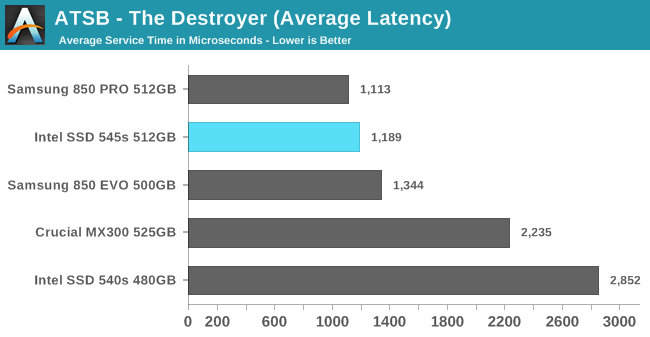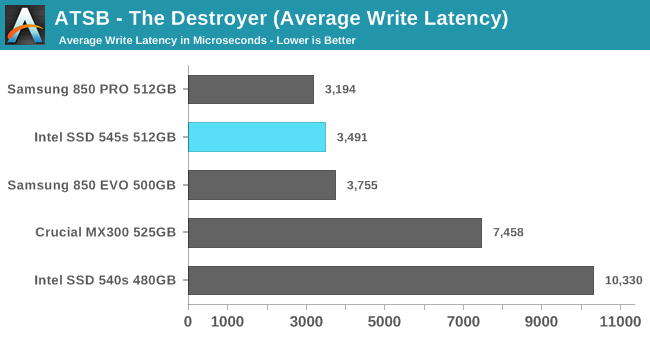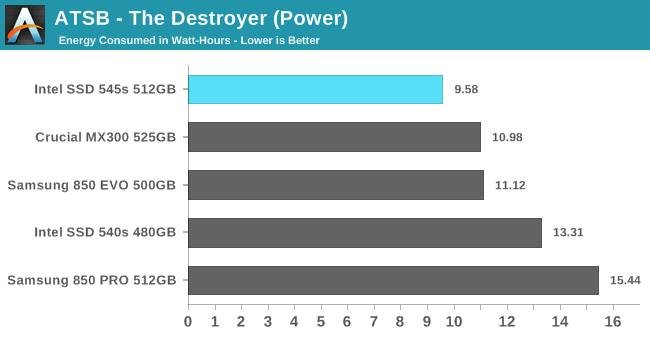The Intel SSD 545s (512GB) Review: 64-Layer 3D TLC NAND Hits Retail
by Billy Tallis on June 27, 2017 6:00 AM ESTAnandTech Storage Bench - The Destroyer
The Destroyer is an extremely long test replicating the access patterns of very IO-intensive desktop usage. A detailed breakdown can be found in this article. Like real-world usage, the drives do get the occasional break that allows for some background garbage collection and flushing caches, but those idle times are limited to 25ms so that it doesn't take all week to run the test. These AnandTech Storage Bench (ATSB) tests do not involve running the actual applications that generated the workloads, so the scores are relatively insensitive to changes in CPU performance and RAM from our new testbed, but the jump to a newer version of Windows and the newer storage drivers can have an impact.
We quantify performance on this test by reporting the drive's average data throughput, the average latency of the I/O operations, and the total energy used by the drive over the course of the test.

The Intel SSD 545s performs surprisingly well on The Destroyer, with an average data rate that surpasses the Samsung 850 EVO and potentially makes the 545s the new fastest SATA SSD with 3D NAND. The 3D MLC-based Samsung 850 PRO is still out of reach, but the 545s is a big improvement over the 540s and the Crucial MX300.

The Intel 545s also ranks between the Samsung 850 PRO and 850 EVO in terms of average latency, with slightly more than half the latency of the Crucial MX300 and an even wider margin over the Intel 540s.


Separating the latency according to reads and writes, we see that the 545s is much closer to the Samsung 850 PRO than the 850 EVO for reads. The write latencies of the Samsung drives and the 545s are all much lower than the Crucial MX300 or Intel 540s.

In addition to delivering great performance for a SATA TLC SSD, the Intel 545s brings a huge improvement in power efficiency. The 545s uses 12% less energy than the Crucial MX300 or Samsung 850 EVO over the course of the test. Only a few SSDs have ever completed The Destroyer on such a small energy budget, and only one other TLC SSD has been this efficient.










74 Comments
View All Comments
ddriver - Tuesday, June 27, 2017 - link
Great, now if they could just make a decent NVME SSD as well.ddriver - Tuesday, June 27, 2017 - link
Shame it took them entire 3 years to catch up to the 850 pro. Lets hope they will match the 960 pro before 2020 LOL.eddieobscurant - Tuesday, June 27, 2017 - link
They caught up with the 850 evo, not the proATC9001 - Tuesday, June 27, 2017 - link
True...but atleast for the first time in I think...ever, there's a drive that can compete with the EVO...hopefully we can see the EVO drives start to drop a bit.Alexvrb - Tuesday, June 27, 2017 - link
It IS nice to see some serious competition for the Evo. The 850 Evo is still my go-to for upgrading older systems from a mechanical drive.Now all I need is some serious price drops for lower-performance higher-capacity TLC drives and I can ditch the mechanical drive for mass storage too. Price:capacity hasn't budged much in recent memory. :-/
Impulses - Tuesday, June 27, 2017 - link
Hasn't budged at all... I bought two 1TB EVOs two years ago, almost to the date (Newegg invoice is dated 7/15/2015 for the first one), paid $340 for one and a couple weeks or a month later I managed to get a second one for $320.I was hoping two years later I could buy a 2TB drive to add to those for the same kinda money, instead the prices are exactly the same right now. The recent shortage and price hike didn't help, up until that point I remember prices steadily declining for at least 4-5 years straight...
I guess that couldn't last, historically the flash market has been more volatile (no pun intended) than not, the kind of stability that went on for a couple years aligned with Samsung's rise to SSD dominance were kind of rare in the grand scheme.
At this rate it's gonna be another 3+ years before I can score a couple good 2TB drives for $300/ea, meh.
andychow - Tuesday, June 27, 2017 - link
Nand is in shortage, has been for a few years. In the past, manufacturers would ramp up production, there would eventually be a surplus, and prices would crash. This time around, they've all decided to basically to ride out the shortage by telling their clients to wait.Alexvrb - Wednesday, June 28, 2017 - link
That seems strange. If they have the ability to ramp and fill demand, you would think one of these outfits would be happy to fill that gap and steal those sales. I thought perhaps they are unable to ramp the flash which is in greatest demand. I hope things get better with future heavily-layered TLC/QLC and upgraded controllers. I would like nothing more than to ditch my secondary mechanical drive for flash, but there's no way I'm spending that kind of money.ddriver - Thursday, June 29, 2017 - link
There is nothing strange about it, they know if flash is in shortage they will make more on every grain of sand they put into it. It is like an implicit mutual agreement to sustain an artificial shortage to make more money. And everyone is happy.They still sell as much SSDs as they can, but at a higher price. SSDs are available, but the supply is deliberately held tight, so there is a perpetual "they might run out" even though supply exceeds demand, it is carefully kept short. Nobody is waiting on flash, no company is missing on sales, they still sell as much as they can, they simply take care not to exceed demand by too much, so they do less work to get extra profits. It is an immensely great deal for them.
There is no motivation for any of the big players to end this shortage, because that would drive prices down, hurt their own margins and those of everyone else, and give the others an excuse for hostile actions in retaliation, which they don't really want, because even though to us they are apparent competitors, they are all in it for the money, and they have estimated that cooperating to keep supply tight will win them more than competing who will make the most or the best SSDs.
It sounds like it is illegal, but considering it is all common sense and they didn't have to collude in some dark room to make an explicit agreement to do so, it is perfectly legal as far as the corrupt justice system is concerned.
Error415 - Tuesday, October 3, 2017 - link
Yeah, it should be illegal for a company to decide not drive prices down by flooding the market with cheap products, shm.What sounds illegal to you is a text book example of a sustainable business model. No booms or busts just steady growth and profit.